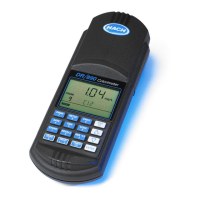32
SECTION 4, continued
4.1 User-Entered Programs
The instrument allows storage of up to ten user-entered programs
(101–110) and up to 113 Hach programs. A minimum of two data
points are required for the instrument to recognize and accept a
user-entered program.
• Program numbers 101 through 110 are reserved for storing
user-entered programs.
• The maximum number of data points that can be entered for a
method is 12. After the twelfth standard (1 through 12) is
accepted, the instrument stores the method and will not
accept any more data, but will allow the user to review the
data already entered.
Before entering a calibration, determine the optimum
wavelength, timing sequences (if any), and the workable range of
the method.
4.2 Calibration Curves
Calibration curves may have positive or negative slopes, but they
must be based on absorbance (% transmittance not allowed) and
must pass through the origin that represents zero concentration.
It is important that the standards adequately describe the curve
over the range of interest. Because this is largely dependent on
the shape of the curve, it may be necessary to prepare a
preliminary curve using extra data points to help select the
appropriate standards.
If the curve is linear, only two concentration data points are
needed. For example, standards with a zero absorbance and a
standard with 1.000 absorbance are appropriate. If the curve is
nonlinear, additional data points are needed to achieve good
accuracy. Up to 12 data points can be entered for a single
calibration curve.
4.3 User-entered Program Information for Bleaching Chemistries
Although the majority of colorimetric test procedures produce a
higher absorbance (i.e. deeper color) as the concentration of the
parameter being measured increases, some tests do the opposite.
These bleaching chemistries (fluoride is one example) produce a

